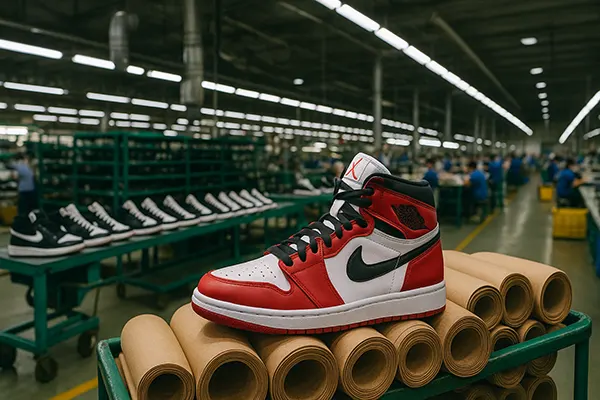
Air Jordan Production in Numbers: Environmental Impact, Factories and Materials
The iconic Air Jordan brand, born from a partnership between Nike and basketball legend Michael Jordan, has long stood for more than athletic excellence—it represents culture, status, and innovation. Yet, in recent years, consumers have begun to ask tougher questions: Where are these shoes produced? What are their ecological consequences? And what is Nike doing to reduce their environmental footprint? This article explores the real numbers behind Air Jordan production in 2025, shedding light on factory locations, carbon emissions, and the evolution of sustainable materials.
Where Air Jordans Are Made: Global Factory Overview
As of 2025, the majority of Air Jordan production is concentrated in Southeast Asia. Vietnam remains the leading manufacturer, followed closely by Indonesia and China. These countries offer large-scale manufacturing capacity and a skilled workforce accustomed to producing athletic footwear at high volumes. Despite criticisms over labour conditions, Nike reports annual audits and claims incremental improvements in transparency and employee rights within their supply chain.
Factories involved in Air Jordan production are classified as Tier 1 suppliers—responsible for final assembly. According to Nike’s latest manufacturing map, more than 130 factories contribute to the production of various Jordan models. About 70 of these facilities are located in Vietnam, making it the epicentre of Jordan manufacturing.
Since 2022, Nike has shifted some production to Indonesia and India to diversify logistics and respond to geopolitical instability. However, Vietnam continues to dominate due to its streamlined production chains and existing infrastructure tailored to Nike’s specifications.
Labour and Transparency Concerns
While factory distribution remains efficient, concerns persist regarding workers’ rights, safety, and compensation. In 2024, the Fair Labour Association conducted third-party assessments across multiple Nike suppliers. The results showed gradual improvements but highlighted gaps in overtime pay, freedom of association, and heat stress protections—especially during production surges aligned with major Jordan releases.
To mitigate these issues, Nike pledged to implement climate-adaptive factory standards by the end of 2025, including revised ventilation systems, ergonomic workstations, and partnerships with local unions. Whether these changes will lead to long-term improvements remains a subject of scrutiny from international watchdogs and sustainability advocates.
Transparency remains a key challenge. Though Nike publishes factory data, independent verifications are still limited. Consumers seeking more accountability often rely on NGO reports, which urge Nike to open supply chains to broader third-party reviews.
CO₂ Emissions from Air Jordan Production
One of the most scrutinised aspects of sneaker manufacturing is carbon output. According to a 2024 lifecycle analysis commissioned by Stand.earth and supported by academic partners, the production of a single pair of Air Jordan 1 generates an average of 13.5 kg of CO₂-equivalent emissions. This figure includes material sourcing, factory energy use, packaging, and transportation to retail points in North America and Europe.
For comparison, the global average CO₂ emission per person per day is approximately 13.2 kg, meaning one pair of AJ1s can match a person’s entire daily carbon footprint. While Nike’s Flyleather and recycled polyester help lower some of these figures, the bulk of emissions still come from synthetic rubber soles and non-renewable energy use in factories.
To counteract this, Nike launched the “Move to Zero” initiative, aiming to cut their total carbon footprint by 70% before 2030. This includes integrating renewable energy sources in key production hubs and optimising shipping routes to reduce emissions per unit.
Carbon Offsets and Criticism
In 2023, Nike began purchasing carbon offsets to balance the impact of its flagship Air Jordan releases. These offsets support forest preservation projects in Southeast Asia and reforestation in the US. While this strategy may appeal to climate-conscious consumers, environmentalists remain sceptical, arguing that offsets are not a substitute for reducing emissions at the source.
Moreover, many environmental groups argue that real climate responsibility lies in minimising overproduction. Limited edition releases and artificial scarcity continue to fuel demand and lead to unnecessary shipping and returns—adding hidden emissions to the lifecycle.
Nike has responded by pledging to make 40% of new Air Jordan models from at least 50% recycled materials. By 2025, this has been partially achieved, with some AJ1 and AJ4 releases incorporating Flyknit uppers made from post-consumer waste, though adoption remains inconsistent across the product line.
Sustainable Materials in Air Jordan Models Post-2019
Since 2019, Nike has incorporated a broader range of sustainable materials into Air Jordan sneakers. Among the most notable is Flyleather—a composite material made with at least 50% recycled leather fibres. First introduced in general Nike lines, Flyleather made its way into select Air Jordan 1 releases by 2021 and now features prominently in lifestyle-oriented editions.
Recycled polyester has also gained traction. Derived from plastic bottles and textile waste, it is used in linings, laces, and even outer layers. In some 2025 AJ4 and AJ1 Mid variants, over 60% of the upper is made with these fibres, significantly reducing dependence on virgin materials.
In addition, Nike has begun exploring algae-based foam as a substitute for traditional EVA in midsoles. This innovation is still in pilot stages but is expected to appear in future Air Jordan hybrids, especially those aimed at eco-conscious markets in the EU and North America.
Challenges with Scaling Sustainable Components
Despite progress, scaling eco-friendly materials remains complex. Flyleather and recycled polyester are more viable for lifestyle models than performance basketball shoes, which require durability and structural precision. This leads to a dual production system—sustainable options for collectors and everyday wearers, and conventional materials for professional use.
Another challenge lies in aesthetic appeal. Traditional sneakerheads often prefer the classic feel and look of full-grain leather and suede. This tension between performance, sustainability and consumer preference limits how aggressively Nike can shift away from conventional inputs without alienating its core base.
To address this, Nike has increased investment in material R&D, aiming to blend recycled content with tactile quality. The brand is also working with designers to ensure that sustainable options maintain the iconic visual identity of the Jordan brand.

Responding to Fast Fashion Criticism
Nike has not been immune to the broader backlash against fast fashion. Critics argue that the constant rollout of limited edition sneakers encourages waste, overconsumption, and resale market inflation. In response, Nike has begun experimenting with pre-order models and digital customisation to limit surplus inventory.
In 2024, the company launched “Jordan Made to Order” in select regions, allowing customers to personalise shoes with a four-week delivery window. While slower, this approach reduces excess production and returns—two key contributors to carbon waste in footwear retail.
Moreover, Nike is piloting a take-back scheme for worn-out Jordans in collaboration with recycling firms in California and the Netherlands. Returned shoes are either disassembled for material reuse or transformed into Nike Grind, a recycled surface material used in sports facilities.
Public Perception and Marketing Realignment
To align with evolving values, Nike has shifted its marketing tone. Instead of pushing scarcity and hype, newer campaigns for sustainable Jordans focus on craftsmanship, longevity, and personal expression. This reflects a broader industry trend where brands are judged not only by style but by substance.
In 2025, over 20% of Air Jordan campaign materials were produced using renewable energy and printed with soy-based inks. The brand also hosted sustainability roundtables, featuring designers and activists, to demonstrate accountability and public dialogue around its impact.
Despite these changes, challenges remain. As long as demand continues to outpace responsible production models, tensions between growth and sustainability will persist. Still, Air Jordan’s journey towards a greener footprint has made measurable strides—and sets a benchmark for other legacy brands to follow.
